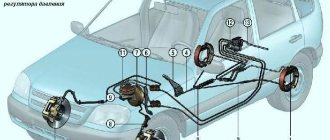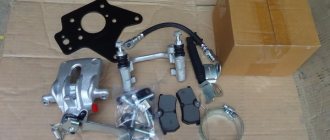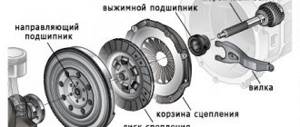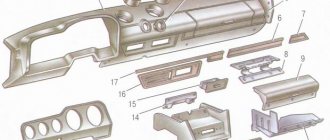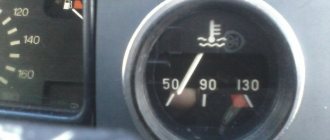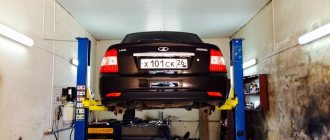When should you change the fluid?
The brake system of the VAZ-2106 needs timely maintenance and replacement of components. The fluid needs to be changed in the following cases:
- With a large resource. Brake fluid contains many additives that can increase the efficiency of the system as a whole and improve cooling. During operation, the tubes can heat up by several hundred degrees.
- When replacing tubes and hoses. The resource of these elements does not depend on operation. Even if the car stands for a long time, the rubber elements dry out and lose their elasticity. There is a fluid leak.
- When repairing the VAZ-2106 master brake cylinder and calipers. As a rule, it is not always possible to completely drain the brake fluid from the system. And you shouldn’t refill it if it has worked for more than 1.5-2 years.
If the liquid works for a long time, then it constantly heats up to critical temperatures. As a result of this, all additives evaporate and the effectiveness of the brakes becomes much lower.
Replacing the GTZ on the “six”
To replace the master brake cylinder of a VAZ-2106, you will need a minimum set of tools - a special wrench and an open-end wrench of 8, a socket or head of 13. To replace the GTZ, you need to perform the following steps:
- Pump out all the liquid from the tank using a bulb.
- Remove the expansion tank.
- Use a special wrench to rip off the tubes.
- Unscrew the tubes and put them aside.
- Unscrew the two nuts securing the GTZ to the vacuum booster.
- Remove the cylinder.
Install the new one in reverse order. Upon completion of the work, liquid is poured into the system. It is imperative to carry out bleeding - due to air locks, the brakes will not be effective enough. Try to fill only with the fluid that has been used previously and is recommended by the car manufacturer. Other fluids can harm the brake system, causing corrosion and leakage. And now it’s time to find out how to bleed the brakes on a VAZ-2106 with your own hands.
We bleed the brakes of a VAZ 2106
As soon as the first signs of airiness in the brake system appear, correct it without delay. Because air locks can cause the brake pedal to sink and the brakes to not work properly. And this is the safety of you and others on the road. Signs of airy brakes
- The brake pedal falls
- Brake fluid is leaking
- The car does not brake clearly
- Brake fluid is below the minimum level in the reservoir
Before bleeding the brakes, be sure to find out the cause of the leak. This article only discusses the process of bleeding the brake system. Fill only with brake fluid intended for your vehicle.
- Two tubes of the appropriate diameter
- Pumping container
- The key used to unscrew the fitting
- Fuel system check valve from VAZ 2108 (its index is 2108-11560010-02)
What is needed for pumping?
To bleed your brakes, you will need the following tool:
- Special key for 8 crimp type. That's what it's called - a brake pipe wrench.
- Open-end wrenches for 8 and 10.
- Jar - volume 0.3-0.5 liters.
- The tube is transparent - you can use the one that connects the windshield washer nozzles to the pump.
It is also necessary to have a supply of brake fluid. The system holds 0.5 liters. Therefore, it is advisable to buy with a reserve - fortunately, it is not very expensive, about 300 rubles per 1 liter. The rest can be used for topping up or at the next refueling.
Replacing brake fluid on a VAZ 2106 car
Replace the brake fluid in the hydraulic brake drive once every two years, regardless of the mileage of the VAZ 2106. Brake fluid is hygroscopic and absorbs water from the air, therefore, if it is not replaced in a timely manner, the mirrors of the working cylinders corrode, which leads to brake failure. Before replacing the brake fluid on a VAZ 2106 car, check the tightness of the hydraulic drive (see “Checking the tightness of the hydraulic brake drive”). Troubleshoot. After checking, do not install the wheels (the brake drums must be installed), since it is more convenient to work with the wheels removed. To replace the brake fluid on a VAZ 2106 car, you will need: brake fluid, a hose for bleeding the brakes, an 8-point wrench, a 10-point wrench (two), a container for drained brake fluid, a spacer (spark plug wrench).
USEFUL ADVICE When replacing brake fluid, carry out the work of replacing the brake fluid with an assistant, with the car mounted on an inspection ditch or a lift.
WARNING If you are working on an inspection ditch, before starting work, raise the front of the vehicle and place it on reliable supports.
1. Remove the brake reservoir cap with the level sensor float. 2. Fill the brake reservoir with clean brake fluid to the bottom edge of the filler neck. 3. Remove the front wheels
4. Clean the fittings of the front wheel cylinders and...
5... rear brake mechanisms.
6. If you are working on a lift (the rear wheels are suspended), first unlock the pressure regulator in the rear brake drive, simulating the load on the rear wheels. To do this, disconnect the rod a
from torsion lever
b
(rear view of the rear axle). Holding the bolt head, unscrew the nut and disconnect the torsion bar from the strut.
7. Install a spacer 130-160 mm high between the end of the torsion arm and the rear axle housing. A spark plug wrench (about 145 mm long), included in the standard tool kit, is suitable for this purpose.
8. Remove the protective cap from the air bleeder fitting of the rear right wheel cylinder and place a hose on the fitting. NOTE Replace the fluid first in one brake circuit, then in the other, each time starting with the brake mechanism furthest from the master cylinder. The order of the contours does not matter.
9. Press the brake pedal 4-5 times and keep it pressed.
10. Place the other end of the hose into a container for drained brake fluid. 11. Unscrew the brake fitting approximately 3/4 of a turn. 12. While continuing to press the brake pedal, displace the fluid in the drive through the hose into a container. 13. After the pedal reaches its extreme forward position and the flow of brake fluid stops, tighten the fitting. 14. Repeat steps 10-14 until the brake fluid in the drive is completely replaced (clean brake fluid without air bubbles should come out of the hose).
WARNING To prevent air from entering the brake system, constantly replenish the reservoir with new brake fluid (do not allow the fluid level to drop below 10 mm from the bottom of the reservoir). This will ensure that the old brake fluid is gradually replaced by the new one without draining the brake system.
15. Repeat steps 10-14 for the second wheel (left rear) of the same circuit, then sequentially for both wheels (right, then left front) of the second circuit. 16. Close the brake reservoir cap. 17. Check the quality of the work done: press the brake pedal several times, and the pedal travel and force on it should be the same with each press. If this is not the case, bleed the brake system.
- Author: admin
Rate this article: Share with friends!
Related posts:
replacing the coolant temperature indicator sensor (DTOZH) on a VAZ 2106 car
replacing a sidelight on a VAZ 2106
replacing the side turn signal on a VAZ 2106
Work procedure
Before bleeding the brakes on a VAZ-2106, you need to check the tightness of all pipes to prevent leakage. Particular attention should be paid to those components that were repaired before pumping. It is advisable to work together. Bleeding order: from the farthest wheel to the nearest one. The rear right wheel mechanism is pumped first, the front left wheel last.
The procedure looks like this (using the first wheel as an example):
- The assistant gets into the car and waits for the command.
- You pour some liquid into the container and lower the tube into it. Place the other end on the bleeder fitting. Be sure to rip off all the fittings in advance with a special wrench.
- The assistant needs to press the VAZ-2106 brake pedal all the way 4-5 times. During the last swing, fix the pedal to the floor.
- You need to unscrew the fitting ½-1 turn to let the air out. After that, tighten it back.
Steps 3 and 4 must be carried out until brake fluid without air begins to flow through the tube. Once completed, tighten the fitting and proceed to bleeding the next brake mechanism. And so on until you get rid of air in the system.
Bleeding the system
After carrying out any work related to the replacement or repair of brake system parts, the brakes should be bled. This will remove air from the line and equalize the pressure.
Tools and tools:
- jack and wheel wrench;
- key to "8";
- rubber or silicone hose with a diameter of 6 mm;
- a small, clean, dry container (preferably transparent);
- brake fluid (to top up).
In addition to all this, you will definitely need an assistant to bleed the system.
Work order:
- Place the car on a horizontally flat surface. Loosen the nuts securing the front right wheel.
- Raise the car body with a jack. Unscrew the nuts completely and remove the wheel.
- Remove the cap from the fitting of the working brake cylinder.
- We put one end of the hose on the fitting. We insert the second end into the container.
- We give the command to the assistant to sit in the passenger compartment and depress the brake pedal 4–6 times, and then hold it in the depressed position.
- When the pedal is depressed after a series of pressures, use a key set to “8” (in some modifications to “10”) and unscrew the fitting three-quarters of a turn. At this time, liquid will flow from the fitting into the hose and further into the container, and the brake pedal will lower. After the pedal hits the floor, you need to tighten the fitting and ask an assistant to release the pedal.
- We pump until brake fluid without air begins to flow from the system. Then you can tighten the fitting, put the cap on it and install the wheel in place.
- By analogy, we bleed the brakes for the front left wheel.
- We pump the rear brakes according to the same scheme: first the right one, then the left one.
- Upon completion of pumping, add brake fluid to the level in the reservoir and check the brakes on a section of the road with low traffic.
Video: bleeding the brakes
At first glance, the process of replacing or repairing a vacuum brake booster may seem somewhat complicated. In fact, you just have to understand everything in detail, and you won’t need the services of specialists.
Is it possible to bleed the brake system without an assistant?
There are several ways to bleed the brake system without a partner. The simplest one is to take the expansion tank cap and modify it a little. To do this, install a fitting with a spool. You will also need a regular camera or wheel. You need to screw the cap onto the tank and install the tube onto the chamber fitting. Its second end is put on the fitting in the expansion tank plug.
And now briefly about how to bleed the brakes on a VAZ-2106 in this way:
- Press the brake pedal all the way and lock it.
- Unscrew the bleeder fittings on the wheel brakes one by one.
- Monitor the fluid level in the system - top up in a timely manner.
- When finished, tighten all threaded connections.
Try not to mix different types of liquids - this can lead to overheating in the system and unstable operation.
How to bleed the brakes on a VAZ-2106 with your own hands
Every motorist should know how to bleed the brakes on a VAZ-2106 or a similar model. Roughly speaking, bleeding the brake system on absolutely all cars (without ABS) is done the same way, even the scheme is similar. Differences can only be found in cars with right-hand drive - on them the pumping scheme is displayed in a mirror. But since cars of the “classic” series have a left-hand drive, air pockets from the hydraulic brake drive are expelled according to the standard scheme.

